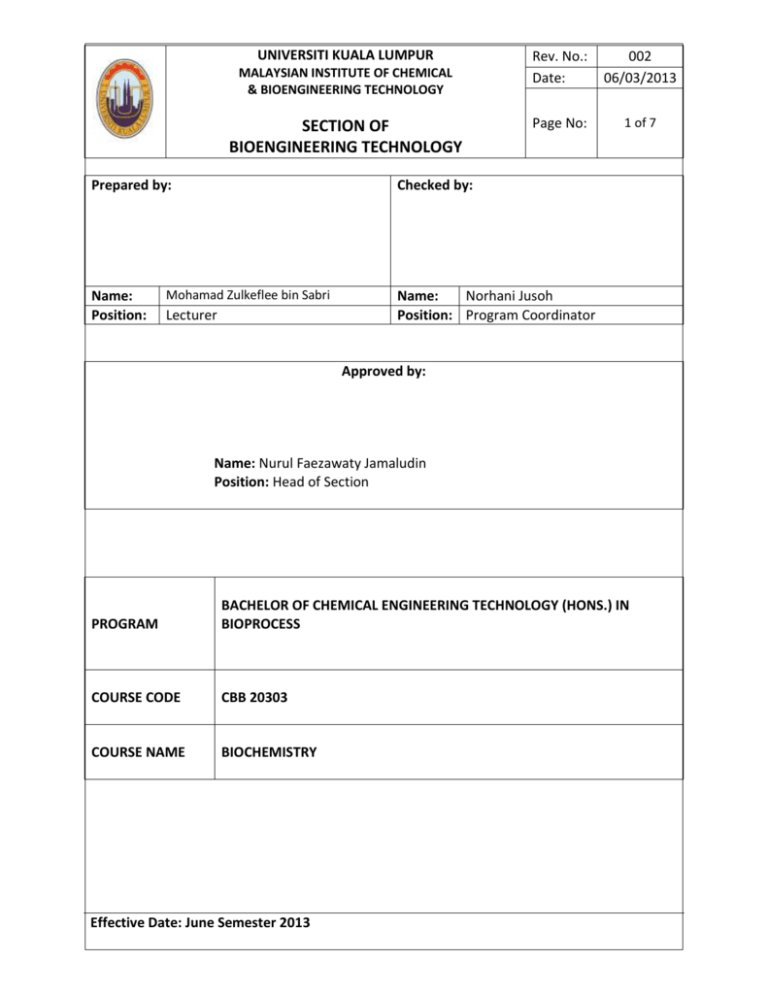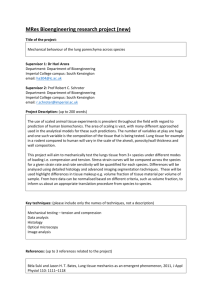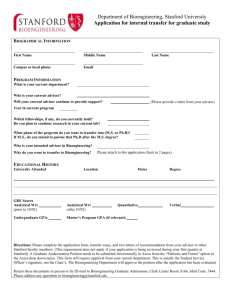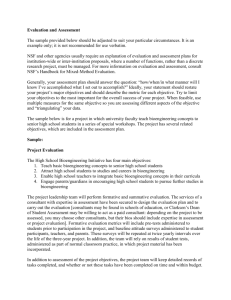
UNIVERSITI KUALA LUMPUR
MALAYSIAN INSTITUTE OF CHEMICAL
& BIOENGINEERING TECHNOLOGY
SECTION OF
BIOENGINEERING TECHNOLOGY
Prepared by:
Name:
Position:
Rev. No.:
Date:
002
06/03/2013
Page No:
1 of 7
Checked by:
Mohamad Zulkeflee bin Sabri
Lecturer
Name:
Norhani Jusoh
Position: Program Coordinator
Approved by:
Name: Nurul Faezawaty Jamaludin
Position: Head of Section
PROGRAM
BACHELOR OF CHEMICAL ENGINEERING TECHNOLOGY (HONS.) IN
BIOPROCESS
COURSE CODE
CBB 20303
COURSE NAME
BIOCHEMISTRY
Effective Date: June Semester 2013
UNIVERSITI KUALA LUMPUR
MALAYSIAN INSTITUTE OF CHEMICAL
& BIOENGINEERING TECHNOLOGY
SECTION OF
BIOENGINEERING TECHNOLOGY
1.
2.
3.
4.
5.
6.
7.
8.
9.
10.
002
06/03/2013
Page No:
2 of 7
Name of Course
Biochemistry
Course Code:
CBB 20303
Names of Academic Staff:
Mohamad Zulkeflee bin Sabri
Rationale for inclusion of the course in the program:
To introduce biochemistry to the students by exposing them to the structure and
functions of biomolecules, enzyme characteristics and reactions, metabolism and
bioenergetics, and biological information flow.
Semester and
Semester 4
Year Offered
Year 2
Total Student Learning Time Face to face (F2F):
Total guided and
(SLT): 120 h
70 h
independent learning
(non F2F): 50 h
L= Lecture
L
T
P
O
T=Tutorial
P=Practical
28
36
6
O=Others
Credit Value:
3
Prerequisite:
Nil
Learning Outcomes:
At the end of this course the students will be able to:
1. Illustrate the fundamental structure and dynamics of biomolecules, and the
principles of biochemistry in organisms.(C3)
2. Justify the basic principles of central dogma of molecular biology, and its
manipulation techniques.(A3, CT)
3. Conduct the biochemistry laboratory works based on the theory learned.(P4)
4. Demonstrate the ability to work in a team either as a leader or an ordinary
member. (TS)
Transferable skills
Skills
1. Practical
laboratory works
2. Teamwork
11.
Rev. No.:
Date:
Development of the skills
Familiarize with equipments
and experimental procedures
in biochemistry
Collaborative learning in
class, work in team during lab
sessions and assignments.
Teaching-learning strategy
Effective Date: June Semester 2013
Skills assessments
Lab test and lab reports
Teacher’s observation –
rubric
UNIVERSITI KUALA LUMPUR
MALAYSIAN INSTITUTE OF CHEMICAL
& BIOENGINEERING TECHNOLOGY
SECTION OF
BIOENGINEERING TECHNOLOGY
Rev. No.:
Date:
002
06/03/2013
Page No:
3 of 7
Teaching and learning will be via lecture, collaborative learning, oral presentation,
group discussion and practical laboratory works. Students will also be required to do
their own self-study either through guided questions and assignments.
Assessment strategy:
PRST.
TOTAL
T1
T2
LR
& LAB
FINAL
KPI
%
TEST
CLO 1
Q1,Q2 Q1, Q2
Q1-Q8
30%
>50%
CLO 2
Q3,Q4
Q3, Q4
CLO 3
CLO 4
Q1-Q8
L1-L9
Peer
evaluation
P1, LT
30%
>50%
38%
>50%
2%
>50%
12.
Synopsis
The subject comprises of structure and functions of biomolecules, properties of
enzymes, metabolism and bioenergetics, and biological information flow. This basic
biochemistry knowledge is used rigorously as a basis of understanding the bioprocess
activity. Through the practical sessions, the students will familiarize themselves with the
types of frequently used equipments and experimental procedures in biochemistry.
13.
Mode of Delivery
Lecture, Collaborative Learning and Practical
14.
Assessment Methods and Types
Written Test
:
Lab Report
:
Mini Project/Lab test
:
Final Exam
:
Total
:
15.
20%
20%
20%
40%
100%
Mapping of the Course to the Program Aims
Course
PEO1
√
Biochemistry
Effective Date: June Semester 2013
PEO2
√
PEO3
PEO4
UNIVERSITI KUALA LUMPUR
MALAYSIAN INSTITUTE OF CHEMICAL
& BIOENGINEERING TECHNOLOGY
SECTION OF
BIOENGINEERING TECHNOLOGY
16.
002
06/03/2013
Page No:
4 of 7
Mapping of the course to the Program Learning Outcomes
P
L
O
1
CLO
1
CLO
2
CLO
3
CLO
4
17
Rev. No.:
Date:
P
L
O
2
P
L
O
3
P
L
O
4
P
L
O
5
P
L
O
6
P
L
O
7
P
L
O
8
P
L
O
9
P
L
O
1
0
P
L
O
1
1
P
L
O
1
2
Teaching
Methodology
Assessment
Lecture, Lab
Tests, Final Exam,
Mini Project
Test, final exam
Lecture, Lab
Lecture, Lab
Lecture, Lab
Lab Report, lab
Test
Rubric- Peer
evaluation
Content outline of the course and the SLT per topic
Topic
1.0
Introduction
1.1 The Chemical Elements of Life
1.2 Important Biomolecules
1.3 The Cell Basic of Life
1.4 Water Molecule
1.5 Ionic and Polar Substances Dissolve in
Water
1.6 pH Scale
1.7 Buffered Solutions Resist Change in pH
2.0
Amino Acids and Primary Structures of
Protein
2.1 General Structure of Amino Acids
2.2 Structure of 20 Common Amino Acids
2.3 Other Amino Acids and Derivatives
2.4 Ionization of Amino Acids
2.5 Peptide Bonds
2.6 Protein Purification Techniques
2.7 Determining Sequence of Amino Acids
Residues
2.8 Protein Sequencing Strategies
Effective Date: June Semester 2013
L
2
2
F2F
T
P
O
Non
F2F
SLT
2
4
2
4
UNIVERSITI KUALA LUMPUR
MALAYSIAN INSTITUTE OF CHEMICAL
& BIOENGINEERING TECHNOLOGY
SECTION OF
BIOENGINEERING TECHNOLOGY
Rev. No.:
Date:
002
06/03/2013
Page No:
5 of 7
3.0
Proteins
3.1 Levels of Protein Structure
3.2 Conformation of the Peptide Group
3.3 Tertiary Structure of Proteins
3.4 Quaternary Structure
3.5 Protein Denaturation and Renaturation
3.6 Collagen
3.7 Structures Myoglobin and Hemoglobin
3.8 Antibodies and Bind and Specific
Antigens
2
2
4
4.0
Properties of Enzymes
4.1 Six Classes of Enzymes
4.2 Enzyme Inhibition
4.3 Regulation of Enzyme Activity
4.4 Mechanisms of Enzymes
4.5 Coenzymes and Vitamins
4
4
8
5.0
Carbohydrates
5.1 Conformation of monosaccharides
5.2 Derivatives of monosaccharides
5.3 Disaccharides and other glycosides
5.4 Polysaccharides
5.5 Glycoconjugates
4
4
8
6.0
Lipids and Membranes
6.1 Structural and Diversity Function of
Lipids
6.2 Fatty Acids
6.3 Steroids
6.4 Other Biological Important Lipids
6.5 Lipid Bylayers and Membranes Proteins
6.6 Membrane Transport
6.7 Transduction of Extracellular Signals
4
8
Effective Date: June Semester 2013
4
UNIVERSITI KUALA LUMPUR
MALAYSIAN INSTITUTE OF CHEMICAL
& BIOENGINEERING TECHNOLOGY
SECTION OF
BIOENGINEERING TECHNOLOGY
7.0
Rev. No.:
Date:
002
06/03/2013
Page No:
6 of 7
6
6
12
4
4
8
3
1
4
3
6
1
2
4
8
6
2
8
3
1
4
3
3
1
1
4
4
3
1
4
2
2
1
3
8
4
2
6
Metabolism and Bioenergetics
7.1 Introduction of Metabolism
7.2 Glycolysis
7.3 The Citric Acid Cycles
7.4 Additional Pathways in Carbohydrates
Metabolism
7.5 Electron Transport and Oxidative
Phosphorylation
7.6 Photosynthesis
7.7 Lipid Metabolism
7.8 Amino Acid Metabolism
7.9 Nucleotides Metabolism
8.0
Biological information flow
8.1 Nucleic acids
8.2 DNA replication, repair, and
recombination
8.3 Transcription and RNA processing
8.4 Protein synthesis
8.5 Recombinant DNA technology
Exp. 1: Introduction to biochemistry
laboratory
Exp. 2: Acid-base titration
Exp. 3: Ammonium sulphate protein
precipitation
Exp. 4: Purification of lysozyme from egg
white by size exclusion
chromatography and its
characterization
Exp. 5: Quantification of lysozyme using
Lowry and Bradford methods
Exp. 6 : Starch hydrolysis by amylase
Exp. 7 : Colorimetric analysis of reducing
sugar
Exp. 8 : Detection of Penicillin G using Thin
Layer Chromatography (TLC)
Exp. 9 : Extraction of DNA
Written Tests (1h duration x 2)
Lab Test
Preparation for Lab Reports
Effective Date: June Semester 2013
6
2
1
UNIVERSITI KUALA LUMPUR
MALAYSIAN INSTITUTE OF CHEMICAL
& BIOENGINEERING TECHNOLOGY
SECTION OF
BIOENGINEERING TECHNOLOGY
Preparation for Quizzes
Final Exam (3h duration)
TOTAL Student Learning Time (h)
28
-
Rev. No.:
Date:
002
06/03/2013
Page No:
7 of 7
36
3
6
1
3
50
2
12
120
18.
References
Preparation for Lab Reports
1. Robert, H. et al. (2006). Principles of Biochemistry. (4th Ed.). Upper Saddle River,
NJ: Pearson Prentice Hall.[QP514.2 .P745 2006]
19.
Other additional information
1. Karen C. T. (2002). General, Organic, and Biological Chemistry. Platinum Edition.
Pearson Benjamin Cummings.
2. Smith, J.G. (2010) General, Organic, and Biological Chemistry. Boston: McGrawHill, 2010.
3. Bettelheim, F.A. and Landesberg, J.M. (2004). Laboratory Experiments for General,
Organic, and Biochemistry (5th Ed.). Brooks Cole.
4. David J. H. (1998). Analytical Biochemistry. (3rd Ed.). Prentice Hall
Effective Date: June Semester 2013







